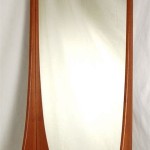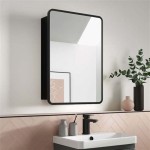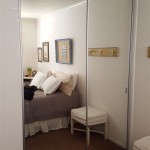How To Put A Mirror On A Brick Wall
Affixing a mirror to a brick wall presents a unique set of challenges compared to drywall or plaster. Brick is a durable, porous material that requires specialized techniques and tools to ensure a secure and lasting installation. Attempting to use conventional methods, such as nails or screws designed for wood, will likely result in damage to the brick and an unsecured mirror.
This article outlines several methods for successfully mounting a mirror on a brick wall, detailing the necessary materials, tools, and procedures. Each method offers a different balance of permanence, ease of installation, and potential for damage to the brick. Selecting the most appropriate method hinges on factors such as mirror size and weight, the desired aesthetic, and the long-term needs of the space.
Selecting the Right Method
Before embarking on the installation process, careful consideration must be given to the various methods available. The choice will be influenced by the size and weight of the mirror. Smaller, lighter mirrors may be suitable for adhesive solutions, while larger, heavier mirrors necessitate mechanical fastening methods. Furthermore, the desired aesthetic plays a role. Some methods are more discreet than others, minimizing the visibility of the mounting hardware.
One option to consider is using heavy-duty adhesive. This approach is best suited for smaller mirrors or decorative tiles that don't bear a lot of weight. The key is to select an adhesive specifically designed for bonding to masonry surfaces. Another option is to drill into the brick and use anchors and screws. This is a more permanent solution, but it requires more preparation and skill. Finally, utilizing a hanging system that relies on brick clips or hangers is another alternative, particularly for mirrors that have a frame or a designated hanging mechanism.
The condition of the brick wall is also a determining factor. Crumbling or heavily textured brick may not provide a secure surface for adhesive or anchors. In such cases, it may be necessary to repair the brick or opt for a method that minimizes stress on the fragile areas.
Adhesive-Based Mounting
Employing heavy-duty adhesive is a less intrusive approach for mounting mirrors onto brick walls, primarily suited for smaller and lighter mirrors. Choosing the correct adhesive is paramount for ensuring a secure and long-lasting bond. Construction adhesives specifically formulated for masonry surfaces are essential. These adhesives are designed to adhere to porous materials like brick and withstand the weight of the mirror. Standard adhesives intended for drywall or wood are unlikely to provide sufficient adhesion and may lead to the mirror detaching.
Surface preparation is crucial to the success of adhesive mounting. The brick surface must be clean, dry, and free from dust, debris, and loose particles. A wire brush can be used to remove any flaking paint or mortar. Following the use of the wire brush, the surface should be wiped down with a damp cloth and allowed to dry completely. Failure to properly prepare the surface will compromise the adhesive's ability to bond effectively.
Applying the adhesive requires careful attention to the manufacturer’s instructions. Typically, the adhesive is applied to the back of the mirror in vertical beads or a zigzag pattern. The mirror is then pressed firmly against the brick wall, ensuring even contact across the entire surface. It is important to support the mirror while the adhesive cures. This can be achieved using painter's tape or a temporary support structure. The curing time for the adhesive will vary depending on the specific product and environmental conditions, such as temperature and humidity.
Prior to applying adhesive directly to the back of the mirror, consider using a mounting plate. This will allow for the adhesive to be applied to the plate, which subsequently attaches to the mirror, minimizing the risk of damaging the mirror's backing. It also makes removal easier, if necessary, in the future.
Mechanical Fastening with Anchors and Screws
For larger and heavier mirrors, mechanical fastening with anchors and screws provides a more secure and reliable mounting solution. This method involves drilling pilot holes into the brick, inserting anchors, and then securing the mirror with screws. Selecting the appropriate anchors and screws is crucial for ensuring a strong and stable connection. Masonry anchors, specifically designed for use in brick and concrete, are essential. These anchors expand within the pilot hole, providing a gripping force that resists pull-out. Standard drywall anchors are not suitable for brick and will not provide sufficient holding power.
Drilling into brick requires specialized tools and techniques. A hammer drill with a masonry drill bit is necessary to penetrate the hard surface of the brick. The size of the drill bit should match the size of the anchors being used. It is important to drill slowly and steadily, applying consistent pressure. Avoid forcing the drill, as this can damage the brick and shorten the life of the drill bit.
Before drilling, carefully mark the desired location for the mirror on the brick wall. Use a level to ensure that the mirror will be straight. Pilot holes should be drilled deep enough to accommodate the entire length of the anchor. Once the pilot holes are drilled, insert the anchors into the holes. Some anchors require tapping into place with a hammer. After the anchors are in place, position the mirror against the wall and align the mounting holes with the anchors. Insert the screws through the mounting holes and tighten them until the mirror is securely attached to the wall. Avoid over-tightening the screws, as this can crack the brick or strip the anchors.
When drilling into brick, there's a high probability of producing dust. Safety eyewear and a dust mask are essential to protect the eyes and respiratory system. It is also advisable to cover nearby furniture and surfaces to prevent dust accumulation. Additionally, it's best to avoid drilling directly into the mortar joints between the bricks, as this could compromise the structural integrity of the wall.
Utilizing Brick Clips or Hangers
Brick clips or hangers offer an alternative mounting solution that minimizes the need for drilling or adhesives. These devices are designed to grip onto the edges of the brick, providing a secure attachment point for hanging mirrors or other objects. This method is particularly useful for mirrors that have a frame or a designated hanging mechanism.
Different types of brick clips or hangers are available, each designed for specific brick sizes and weights. It is important to select a product that is compatible with the dimensions of the brick and capable of supporting the weight of the mirror. Some clips are adjustable, allowing for a more customized fit. Most clips are made of hardened steel or other durable materials. Plastic clips might exist, but they are generally not recommended for more than very lightweight objects.
Installing brick clips or hangers is typically a straightforward process. The clips are simply attached to the edges of the brick, usually by tightening a screw or lever. Ensure that the clips are securely fastened and evenly spaced to distribute the weight of the mirror. Then, hang the mirror onto the clips using the hanging mechanism provided on the back of the mirror.
While brick clips can be a convenient and non-invasive mounting option, it is important to be aware of their limitations. They may not be suitable for very heavy or large mirrors, as the weight limit of the clips can be a constraint. The effectiveness of brick clips also depends on the condition and uniformity of the brick. If the brick edges are uneven or damaged, the clips may not grip securely. Regularly inspect the clips to ensure they are holding securely. External factors, such as temperature fluctuations, can impact their performance.

3 Simple Ways To Hang A Mirror On Wall Without Nails Wikihow

How To Hang A Heavy Mirror Securely Bob Vila

How To Hang A Heavy Mirror On Brick Wall Hanging Tips Easy Tutorial Homify

Mirror On Exposed Brick Chimney Wall Living Room

Cement Wall Gym Mirror Installation Two J Channel Method

How To Hang A Heavy Mirror On Brick Wall Hanging Tips Easy Tutorial Homify

How To Hang A Heavy Mirror On Brick Wall Hanging Tips Easy Tutorial Homify

How To Hang A Heavy Mirror Onto Gyproc Bunnings Work Community

Modern Classic Victorian Cottage Renovation Red Brick Fireplaces Living Room With Fireplace

How To Hang A Heavy Mirror Onto Gyproc Bunnings Work Community








